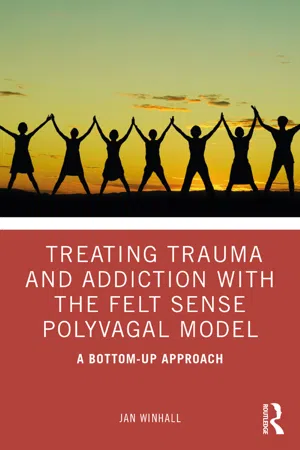
Treating Trauma and Addiction with the Felt Sense Polyvagal Model
A Bottom-Up Approach
- 240 pages
- English
- ePUB (mobile friendly)
- Available on iOS & Android
About this book
In sharp contrast with the current top-down medicalized method to treating addiction, this book presents the felt sense polyvagal model (FSPM), a paradigm-shifting, bottom-up approach that considers addiction as an adaptive attempt to regulate emotional states and trauma.
The felt sense polyvagal model draws from Porges' polyvagal theory, Gendelin's felt sense, and Lewis' learning model of addiction to offer a graphically illustrated and deeply embodied way of conceptualizing and treating addiction through supporting autonomic regulation. This model de-pathologizes addiction as it teaches embodied practices through tapping into the felt sense, the body's inner wisdom. Chapters first present a theoretical framework and demonstrate the graphic model in both clinician and client versions and then teach the clinician how to use the model in practice by providing detailed treatment strategies.
This text's informed, compassionate approach to understanding and treating trauma and addiction is adaptable to any school of psychotherapy and will appeal to addiction experts, trauma specialists, and clinicians in all mental health fields.
Frequently asked questions
- Essential is ideal for learners and professionals who enjoy exploring a wide range of subjects. Access the Essential Library with 800,000+ trusted titles and best-sellers across business, personal growth, and the humanities. Includes unlimited reading time and Standard Read Aloud voice.
- Complete: Perfect for advanced learners and researchers needing full, unrestricted access. Unlock 1.4M+ books across hundreds of subjects, including academic and specialized titles. The Complete Plan also includes advanced features like Premium Read Aloud and Research Assistant.
Please note we cannot support devices running on iOS 13 and Android 7 or earlier. Learn more about using the app.
Information
1 Early Days: The Initiation of a Trauma Therapist
Addiction: It helps you in the short term,hurts you in the long term,and you can’t stop doing it. – JW
Addiction as Behavioural Affect Regulation: A New Frontier
Finding Interpersonal Neurobiology (IPNB)
Experiential Response to Siegel’s IPNB Model
Discovering the Missing Links: The Polyvagal Theory
Origins of the Felt Sense Polyvagal Model of Addiction (FSPM)
Addictive/Adaptive Responses Often Tell a Detailed Trauma Story
Table of contents
- Cover
- Half Title
- Title Page
- Copyright Page
- Dedication
- Contents
- Acknowledgements
- A Prologue: My Women’s Group
- 1 Early Days: The Initiation of a Trauma Therapist
- 2 Finding Focusing and Thinking at the Edge
- 3 Thinking about Thinking about Addiction: Integrating Top-down and Bottom-up
- 4 Addiction: A Very Bad Habit
- 5 Facing the Truth About Addiction
- 6 Bringing the Body to Mind: The Emerging Field of Interpersonal Neurobiology
- 7 Creating A Safe Nest
- 8 Bringing Polyvagal Theory into the World of Addiction
- 9 Experiential Psychotherapy and Gendlin’s Felt Sense: The Whole of a Situation
- 10 Bringing the Model to Life: Going Deep and Thinking Big
- 11 Nuts and Bolts: Embodied Assessment and Treatment Tool (EATT) and Focusing Oriented Therapy Strategies
- 12 An Embodied Experiential Assessment: The Margaritas
- 13 Hailstorms and Turtles: The Felt Sense Polyvagal Dialogue
- 14 Lily and Lucas
- Epilogue
- Index